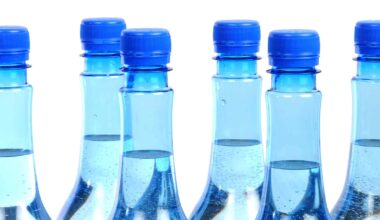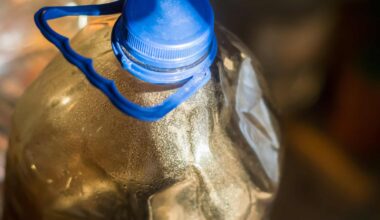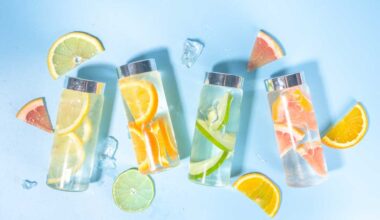Ever found yourself in that awkward spot where you take a sip from your water bottle only to end up with a wet patch on your shirt? You’re not alone, my friend. There’s a high chance that every one of us has been a victim of the ‘leaky water bottle syndrome’ at least once in our lifetime.
Doesn’t it just ruin your day when you find your belongings soaked up in your bag because of a sneaky leak? It’s as if the bottle has a mind of its own, right? And boy, don’t even get me started on the detective work it requires to locate the source of the leak.
But why does this happen? Why does this innocent-looking water bottle that you’ve trusted with your hydration pull such a stunt? Keep reading and we’ll dive into the mystery of the leaking water bottle!
The Surprising Reasons Why Your Water Bottle Is Leaking
Ever found yourself asking, “Why is my water bottle leaking?” You’re not alone. Let’s dive into the surprising reasons that could turn your trusty, stay-hydrated companion into a dampening inconvenience.
The Not-So-Snug Lid
Yes, the issue could be as simple as an improperly tightened lid. Although it seems basic, an unsteady hand, a momentary distraction, or just plain forgetfulness can lead to a less-than-perfect seal. And voila! Your once trusty bottle starts to leak.
Sneaky Cracks and Breaks
Another common culprit – cracks or breaks in the bottle. A slight drop, or a bump against something hard, and your bottle could end up with a hairline fracture invisible to the naked eye. But tiny as it is, it’s enough to set loose a trickle of water that could leave your bag or desk wet.
Worn-Out Seals and Gasketsh
Even the best water bottles aren’t immune to the ravages of time. Overuse or frequent washing can cause the seals or gaskets to wear out. When this happens, water can escape the bottle, even when it’s perfectly upright.
Temperature and Pressure Variations
Ever noticed how your bottle leaks when it’s particularly hot or cold? Temperature variations can cause the plastic or metal to expand or contract, creating gaps. Likewise, changes in pressure (like when you’re climbing a mountain or in a plane) can cause your bottle to leak.
Water Bottle Design Flaws
Sometimes, it’s not you, it’s the bottle. Some designs are simply prone to leakage. Whether it’s a poorly placed drinking spout or a not-so-ergonomic screw-on lid, design flaws can cause your bottle to leak, no matter how careful you are.
Don’t throw your leaking water bottle out just yet – the fix could be simpler than you think. Look out for these common culprits next time your bottle starts to leak and save yourself from the inconvenience of soggy bags and wet desks.
How Your Water Bottle Design May Be Causing Leaks
H2O, when suddenly your shirt is wetter than a seal in a sauna. Sound familiar? Well, there’s a possibility that your bottle design is the culprit behind these mysterious leaks.
The Spout
The spout, my friends, is often the prime suspect in the case of the leaking water bottle. Think of it as the gateway between you and your much-needed hydration. If it’s not properly sealed, you’re in for a soggy surprise.
The Cap
Next on our list of possible culprits is the cap. The cap’s job is to act like the guardian of the water galaxy within your bottle. If it’s not screwed on right or if it’s damaged, it might as well be an open floodgate.
The Bottle Body
Now, let’s talk about the body of your bottle. It’s the vessel that holds your precious life-sustaining elixir. Cracks, warping, or even tiny holes might turn your bottle into a mini water feature.
Seal
Last, but certainly not least, we have the seal. It’s like the unsung hero of your water bottle, often overlooked, but incredibly crucial in keeping your water where it belongs – inside the bottle. A worn or damaged seal can spell disaster for your dryness.
So next time you’re drenched mid-drink, don’t just blame it on clumsy drinking. Take a closer look at your water bottle, it may just be the secret saboteur you never suspected.
The Importance of Properly Securing Your Water Bottle Lid
Imagine this: You’ve just slipped your sleek, shiny water bottle into your brand-new bag only to discover later that it has been leaking. Catastrophe! Your precious items are drenched, and you’re left wondering, “What went wrong?” Well, dear reader, let’s dive into this aquatic mystery.
The culprit could very well be the lid of your water bottle. It’s a component often overlooked in the fight against leaks. But neglecting its importance is a risky game, my friend.
Remember, a water bottle is only as good as its lid. A loose lid is an invitation for trouble.
So, how exactly does a lid factor into the leaky bottle equation? Let’s unscrew the details.
Lid Anatomy 101
First up, it’s worthwhile to understand the anatomy of a standard water bottle lid. It’s usually a two-part affair: the cap and the seal. The cap is the part you twist, flip, or push, while the seal is the rubbery bit that keeps your drink from making an unscheduled escape.
The Role of the Seal
Now, a worn-out or damaged seal is a common reason for a leaky bottle. It’s like the bouncer at the club door – if it’s not doing its job, unwanted spillovers can occur.
How to Secure Your Lid Properly
- Turn it till it’s tight: When securing your lid, ensure it’s tight but not overly so. Over-tightening can lead to thread damage, which is a sure-fire recipe for leaks.
- Check the seal: Regularly check your water bottle seal for damage or wear. If it starts looking like a chewed-up piece of gum, it’s time for a replacement.
- Cleanliness is key: Always keep your lid clean. A buildup of residue can compromise the seal’s effectiveness.
So, there you have it. The next time you find yourself asking “why is my water bottle leaking,” remember to give your lid some love. Happy hydrating!
The Impact of Temperature on Your Water Bottle’s Leakage
Ever wondered why your trusty water bottle suddenly starts leaking when it’s been a loyal companion for so long? The culprit may actually be the temperature. Yes, you heard it right! Something as simple as temperature can play a major role in turning your water bottle into a mini fountain.
Firstly, let’s dive into Hot Temperature. When the water inside your bottle gets heated up, it’s like giving the water molecules some red bull – they start moving and bouncing around more rapidly. This leads to increased pressure which seeks a way out, causing your bottle to leak.
Pro Tip: Avoid leaving your water bottle in hot places like your car on a sunny day. Not only will your drink turn lukewarm (yuck!), but it could start leaking too.
Secondly, let’s talk about Cold Temperature. Cold temperatures can make the materials of your bottle contract or shrink, including the seal. This can create tiny gaps where water can sneak out. It’s like when you lose weight and suddenly your favorite jeans start falling off (if only losing weight was as easy as leaving a water bottle in the fridge!).
- Plastic bottles are more susceptible to temperature changes, whereas metal bottles are generally more robust.
- However, no bottle is entirely immune to the effects of temperature. Even your expensive, fancy vacuum insulated bottle may leak if exposed to rapid temperature changes.
The Solution?
Try to keep your water bottle at a constant, moderate temperature. Don’t expose it to extreme heat or cold. And if you notice your bottle leaking, it might be time to check the seal and possibly replace the bottle. After all, life’s too short for leaky water bottles!
Why Your Water Bottle Cap Could Be Failing You
Ever wondered why your loyal water bottle has suddenly turned traitor, drenching your gym bag or worse, your laptop? Well, Sherlock, it’s time to investigate the case of the leaking water bottle. Often, the culprit is sitting right on top – your water bottle cap!
Yes, you heard it right! The cap is more than just the crown of your water bottle kingdom. It’s the gatekeeper, the sentinel, and when it fails in its duties, we have a ‘wet’ situation on our hands.
But why, oh why, would the cap betray you in such a manner?
Well, the reasons might be simpler than you think. Let’s put on our detective caps (pun absolutely intended!) and dive right in!
The Tale of the Worn-Out Seal
Your cap’s seal may be the unsung hero, stopping water from escaping its confines. But even heroes age, and when the seal gets worn out or damaged, it can cause leakage. Be sure to inspect your bottle’s seal regularly for signs of wear and tear!
The Saga of Overfilling
Ever tried stuffing yourself at a buffet? The aftermath isn’t pretty. The same goes for your water bottle – overfilling can put extra pressure on the cap, causing it to leak. The golden rule? Leave some breathing room!
The Myth of Cross-Threading
Like a classic mismatched jigsaw puzzle, if the threads of your cap and bottle don’t align perfectly, we have a leak! This mishap, known as cross-threading, can occur if you have hastily screwed the cap on. Slow down and make sure everything fits just right!
In conclusion, the cap of your water bottle isn’t just an accessory – it’s a key player in the hydration game. Treat it with care, and it’ll keep your belongings dry and your thirst quenched. Here’s to leak-free water bottles and happier, hydrating times ahead!
What Happens When the Seal In Your Water Bottle Breaks
ing you by leaking all over your new bag? Well, my friends, the culprit is most likely a broken seal. That’s right, the unsung hero of your water bottle isn’t the stylish outer casing but the humble seal, working tirelessly to prevent leaks.
But what exactly happens when this seal breaks? you ask. Let me paint a picture. Imagine you’re a dam keeper, and suddenly there’s a crack in the dam wall. Disaster, right? That’s basically your water bottle’s seal scenario.
- Pressure: Without a functional seal, the pressure inside your bottle can’t be maintained. It’s like a dam with no wall, and water starts escaping, resulting in leaks.
- Temperature: A broken seal affects the bottle’s insulation properties. Your iced tea might not stay chilly for long, and your hot coffee might cool off too soon.
Plus, if the seal’s broken, tiny particles could get inside the bottle, compromising the drink’s purity. No one wants a side of dust with their morning coffee, right?
So, next time you find your water bottle leaking, pay homage to the unsung hero – the seal. It might be time to fix or replace it.
In conclusion, ignoring a broken seal is like trying to row a boat with a hole in it – it just doesn’t work. So, give your seal the love and attention it deserves. After all, it’s what keeps your drink in your bottle, and not all over your stuff.
How Overfilling Your Water Bottle Can Lead to Leaks
Oh, the heartbreak of a leaking water bottle! Especially when you’ve just filled it to the brim with your favorite ice-cold beverage. You might be wondering, “Why on earth is my water bottle leaking?” Well, the answer may be as simple as this: you’re overfilling it.
Yes, overfilling your water bottle can cause those pesky leaks. You might not realize it, but those extra sips of water you eagerly squeeze into your bottle might just be your undoing. Let’s dive into the dynamics of why this happens.
The Science Behind the Spill
Water, like any other substance, expands when heated. So, when you fill your water bottle to the top, there’s no room for the water to expand as it heats up. The result? You guessed it – a leaking water bottle.
The Role of the Cap
Your water bottle’s cap also plays a significant role in this leaking saga. When you screw the cap on an overfilled bottle, the excess water is forced out through the only available route – the cap’s seal. And there you have it, a leak!
So, next time you’re about to overfill your water bottle, remember the science behind the spill and the role of the cap. You might just save yourself from a damp disaster!
The Risks of Using a Damaged Water Bottle
Ever wondered why your trusty water bottle suddenly seems to have taken on the persona of a leaky faucet? Well, keep reading because we’re about to dive into the potential risks of using a damaged water bottle.
The sneaky sidekick: Bacteria
First up, let’s talk about bacteria. A cracked bottle can be a playground for bacteria and mold, especially if it’s constantly filled with liquid. A small crack can become a perfect breeding ground for unwanted microbes.
Leakages can cause a mess
Secondly, a leaky bottle can be a real party pooper. Imagine reaching into your bag for a document or your favorite book, only to find them soaked. Not exactly the most pleasant of surprises, is it?
Chemical Leaching
Finally, if your bottle is made of plastic, a crack can lead to chemical leaching. This means harmful chemicals from the plastic can seep into your water, which you inevitably consume.
Understanding this, it’s crucial to replace your water bottle once it starts leaking to avoid these risks. Because, let’s face it, no one wants to invite bacteria to the party, deal with wet belongings, or sip on chemical-laced drinks.
The Benefits of Investing in a High-Quality Water Bottle
Ever been on a midday walk, reached for your trusty water bottle, and found your bag soaking wet? Yep, you’re nodding. You’ve been there. But, have you ever stopped to wonder why your water bottle is leaking? It’s not because it’s out to ruin your day (even though it feels like it sometimes!).
Here’s where investing in a high-quality water bottle can make a world of difference. Let me tell you why:
- Sturdiness: A high-quality water bottle is designed to withstand knocks and shakes. Its sturdy structure means it’s less likely to crack, keeping your belongings dry and your hydration levels high!
- Sealing technology: These water bottles come with advanced sealing technology. Translation: No more unwanted water shows in your bag. Phew!
- Temperature control: Quality water bottles often feature insulation, keeping your cold drinks cold and hot drinks hot. Perfect for fitness enthusiasts and coffee lovers alike!
Think of a high-quality water bottle as your trusty sidekick, always ready for action. Whether you’re hiking, gymming, or just going about your day, it’s got your back (and your bag!).
Not All Water Bottles Are Created Equal
When it comes to water bottles, you really do get what you pay for. An initial investment can save you from countless leaking mishaps down the road.
Invest in quality, and never deal with a soggy sandwich again!
So next time your water bottle starts acting the squirt gun, remember: it might be time for an upgrade. Because nobody has time for a leaking water bottle, right?
Simple Steps to Prevent Your Water Bottle from Leaking
Oh, the frustration of a leaking water bottle! It’s like a little imp secretly siphoning off your hydration just for the fun of it. But don’t despair – there are some simple steps you can take to keep your bottle right as rain and your belongings dry as a desert.
1. Check the Seal
The first thing you should do is check the seal. Like the goalkeeper of your bottle, the seal is there to block unwanted leaks. A damaged, dirty, or missing seal is often the culprit behind a leaking bottle. Give it a good clean and inspect it for any signs of wear and tear.
2. Screw the Cap Correctly
You’d be surprised how often a leaky bottle is the result of a cap that’s not screwed on correctly. Ensure it’s tight, but not too tight – like a well-fitted hat. You wouldn’t want your bottle to get a headache, would you?
3. Avoid Overfilling
Overfilling is like inviting a leak to happen. Leave a little space at the top – your bottle needs to breathe, after all. It’s not just about capacity, it’s about comfort!
4. Store Uprightly
Storing your bottle upright can also help prevent leaks. It’s all about the gravity, my friend. Give your bottle the upright respect it deserves, and it will reward you by keeping its contents where they belong.
So, there you have it! By checking the seal, screwing the cap correctly, avoiding overfilling, and storing your bottle upright, you can put an end to any hydration heists happening in your bag. Your water bottle, your belongings, and your sanity will thank you.






